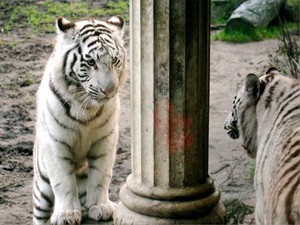
Relevant links:
- White tigers*
More about white tigers. - Black tigers*
More about black tigers. - Bengal tigers
More about Bengal tigers.
White & black tigers
1. White tigers
2. Black tigers
White tigers
In the wild only live white Bengal tigers. Breeding programs accomplished to breed white variants of the other subspecies as well. The white fur is a genetic characteristic, caused by a mutation of the DNA, inherited from the parents. The result is that there are a few possibilities to pass on the genes for a white fur:
A white fur is a recessive gene, so they only inherit a white fur when the tiger carries both recessive lethal genes. Even when the tiger is orange, there is a chance that it will give birth to white cubs, at least if the parents both possess the recessive lethal gene. If two orange tigers that both posses the recessive lethal gene mate, there is a chance of 1 to 4 (25%) that a cub will be white. With an orange and a white tiger, there's a chance of 1 to 2 (50%) (only if the orange one carries the lethal gene). When two white tigers reproduce, there is a chance of 1 to 1 (100%) that their cubs will have a white fur.
According to this theory it is possible that a litter contains of both with and orange cubs.

Black tigers
Black tigers are very rare. Their black fur is genetically determined. So the hereditary part is the same as for white tigers.
Because of their black fur with black stripes, black tigers are often mistaken for a black jaguar. Although black tigers don't appear to have stripes, it is a misconception; because of the black fur, the (little bit darker) stripes are just not that conspicuous.


